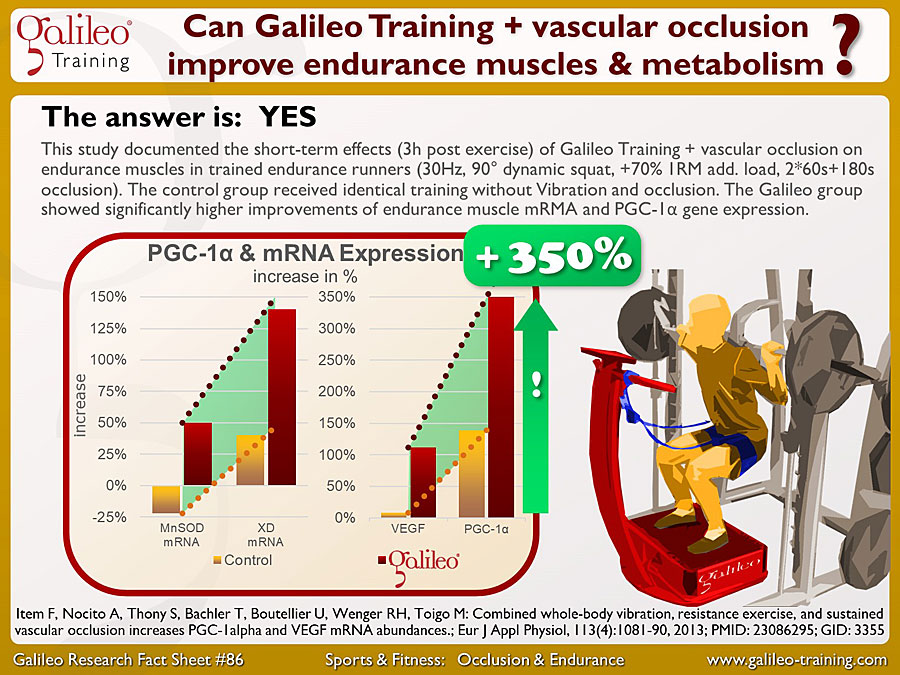During the 1st Berlin Bedrest Study (BBR) individuals had to stay in bed for 55 days completely. The control group did no training at all, the Galileo group received 10 Min., 5 days/week 12-26Hz of intense Galileo Training while in bed. The Galileo group could prevent loss of muscle function almost completely while the control group lost muscle function by up to 28%...
During the 2nd Berlin Bedrest Study (BBR2) the participants had to stay in bed for 55 days. The control group received no intervention at all, the Galileo Training group did resistance exercise + vibration (24Hz, 6x1 min. to exhaustion, 3/week). The control group showed a decrease in immune system (increased inflammation markers decreased immune competence & function) while the Galileo group improved the immune system...
During the 2nd Berlin Bedrest Study (BBR2) the participants had to stay in bed for 55 days. The control group did no training at all, the Galileo group did resistance training + vibration (24Hz, 6x1 min. to exhaustion, 3/week). The Galileo group decreased CK levels to the same values ad the passive control group but received even better training results than the resistance training group which showed the highest CK levels in bedrest...
During the 2nd Berlin Bedrest Study (BBR2) the participants had to stay in bed for 55 days. One control group did no training at all, the second one resistance exercises (RE) and the Galileo group did resistance training + vibration (24Hz, 6x1 min. to exhaustion, 3/week). While both control groups increased local body fat only the Galileo group was able to reduce local body fat by up to 12% with just 18 minutes Training per week...
This study documented the short-term effects (3h post exercise) of Galileo Training + vascular occlusion on endurance muscles in trained endurance runners (30Hz, 90° dynamic squat, +70% 1RM add. load, 2*60s+180s occlusion). The control group received identical training without Vibration and occlusion. The Galileo group showed significantly higher improvements of endurance muscle mRMA and PGC-1α gene expression...
This study compare Galileo Training vs vertical vibration (Power Plate) (Gal: 26Hz, 2,5mm, PP:30Hz, 4mm, static & dynamic 90° squat, 4x60-100s, 10 weeks). All three groups received upper body strength training exercises, the Galileo and Power Plate groups additional vibration training. The Galileo groups showed after 10 weeks of training the highest average improvements in muscle function and muscle power...
This study reported the effects of Galileo Training at high frequencies on blood flow and NO concentration in 58-83 year old individuals (26Hz, pos. 2, 30°-40° squat, 10x30s, 60s rest). The control group performed identical exercises without vibration. The Galileo groups showed significant improvements of blood flow during the training (+15%) and significant increase of NO concentration 5 minutes after the exercise (+43%)...
This study investigated the effects of 8 weeks of Galileo Training on mobility, muscle power, fall- and fracture-risk and bone parameters (age 60-80, 20Hz, pos. 3, 20° squat, 5*1min, 3/week, 8 weeks). Galileo Training improved balance (Berg Balance Scale, BBS) by 8%, muscle power (CRT) by 28%, increased flexibility (range of motion) by up to 50% and increased the Calcaneus bone quality by 0.3 SD...
This study examined during Galileo Training the effects of increasing frequencies and higher squatting angles on pelvic floor activation (EMG in relation to MVC, maximum voluntary contraction) (6-26Hz, 20°-40° squat, Pos. 3). The study shows that increasing knee angles and especially increasing frequencies significantly increase pelvic floor muscle activation up to 15%...
This Study investigated the immediate effects of Galileo Training on the side-differences in one-legged jumping (26Hz, pos. 3, 3 min., bilateral 90° squats, both feet or only one foot on Galileo). The control group performed the identical exercise without vibration. Bilateral Galileo training improved jumping height of the stronger leg, one legged training focused on the weaker leg and decreased the side-difference by 12%...








